Using Art and Poetry to Create Art. Art Sub Lessons, Art Journal Assignments, One Class Art Lessons
- Emily Gould
- Aug 5, 2023
- 14 min read
Updated: Aug 21, 2023
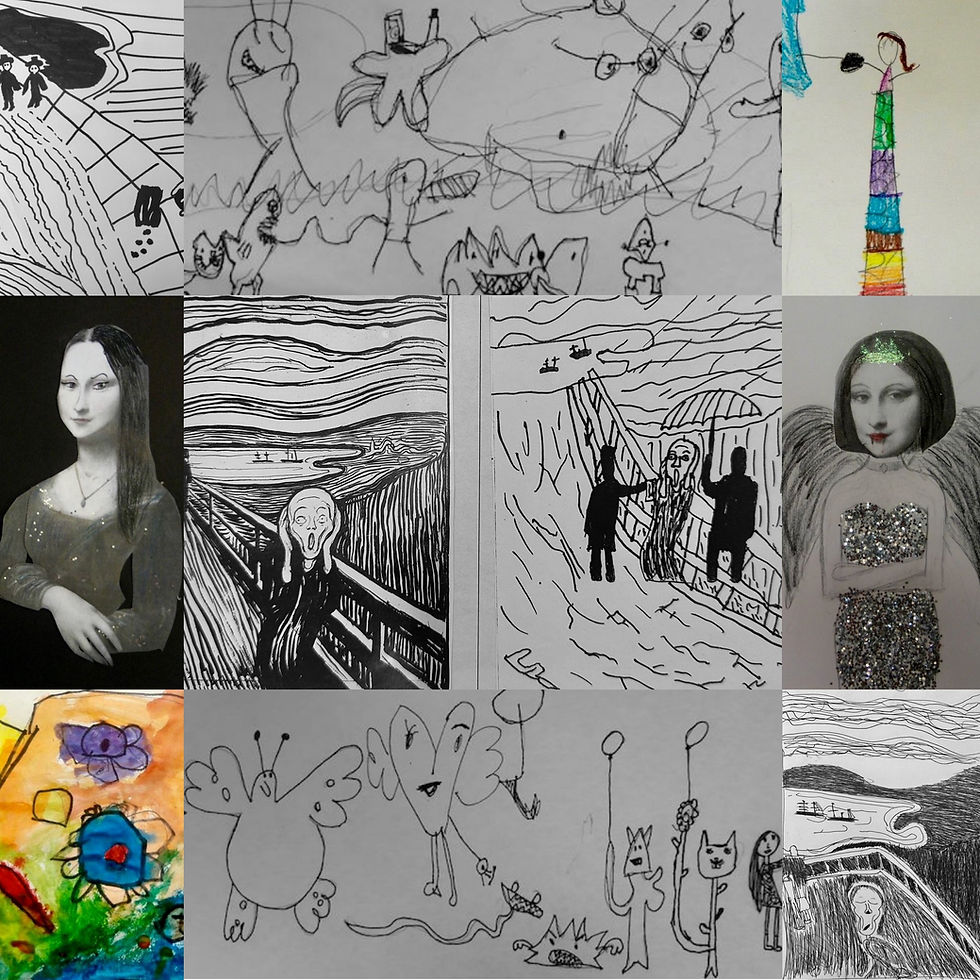
This post examines insights into art history and literature through imagination and a studio process of re-creation. By learning about artists and by sharing in their forms of art expression, respect is gained for the artists, their time periods in history, and their unique style of creating.
These art activities are based on perceptual awareness, art appreciation, and the creation of art in a way that encourages experimentation, self-expression, and creativity while exploring art materials, skills, and art history. This post has four art lessons; Three based on famous works of art and one verbal to visual exercise based on a famous poet's style...
Modern Mona Lisa, Leonardo da Vinci
The Cry, Edvard Munch...What Might Happen Next?
Twittering Machine, Paul Klee...Design A Machine.
A Parade On Another Planet...Edward Lear, From Verbal To Visual.
Some of these art lesson are perfect for early finishers, sub lessons, one day art lessons and/or art journal assignments.
Modern Mona Lisa

Rinat, Grade 9
The Mona Lisa is considered a masterpiece of the Italian Renaissance, This painting is iconic and has been described as "the best known, the most visited, the most written about, the most sung about, [and] the most parodied work of art in the world"! One of the painting's most famous qualities include the subject's mysterious expression, The portrait, in fact, is considered to have an enigmatic facial expression, sometimes smiling, sometimes not, but always with her gaze fixed on the observer. No matter where you stand it seems as if The Mona Lisa is looking right at you, which makes the painting seem mysterious.

Mona Lisa, Leonardo da Vinci. Painted between 1503 and 1519
The Mona Lisa is one of the most valuable paintings in the world. It holds the Guinness World Record for the highest known painting insurance in history at US$100 million in 1962, that's equivalent to $1 billion as of 2023.
Leonardo da Vinci (1452-1519), was born in a town in Italy called Vinci, which he used as his last name. Leonardo was brought up by his grandfather. He lived during a time called the Renaissance, when people in Europe wanted to fill buildings with beautiful artwork. Leonardo was not only a great artist but also an architect, scientist, inventor, musician, and mathematician. He used his drawing skills to help figure out how things that he thought of might work. The notes on his drawings were always written backwards for privacy. He questioned everything. What he learned about nature and science helped him make his paintings look real. His paintings were much more lifelike than those of any other artist of his time.
Leonardo da Vinci used light colors and dark shadows to make his paintings look three-dimensional. His portraits always had a feeling of movement and his backgrounds seemed real.
Questions For Discussion
Why do you thinkMona Lisa's portrait is so well known?
Who do you think she was?
Other than in front of an Italian Landscape where could she be positioned?
People think that her eyes look at them from where ever they are standing. Do you think the same thing?
Modern Mona Lisa

Teacher example. Here Modern Mona is working on her laptop at Starbucks Coffee.
Students used a photocopy of Leonardo da Vinci’s Mona Lisa’s face and created a different body and background. Students drew Mona Lisa in a new setting with a different hairstyle and clothing to reflect this time period. This art lesson encourages exploration, creativity, and self-expression while developing basic art skills and concepts.
Art Supplies
A photocopy of The Mona Lisa, one copy per student.
Scissors
Glue
Pencil
Colored Pencils, Markers, and/or paper for collage
This is the image of Mona Lisa that we used...
I love that this is a very open ended art project. I often give this assignment to upper elementary to high school level. Usually this is an art journal assignment for my older students that are required to keep art journals. This project is easily adaptable for any grade and skill level and would also make a great sub lesson. This art lesson encourages self expression and creative thinking. The results are often surprising and always interesting.

The Modern Mona Lisa art lesson is from the book, Using Art To Make Art by Wendy M.L. Libby available on Amazon. This book is a great resource for the art room. The art activities in this book are based on art concepts, art elements, and principles. If you are looking for more art lessons based on famous works of art I highly recommend this book. The art projects in this book are easily adaptable for any grade/skill level.
Modern Mona Student Gallery
Middle School and High School

Rinat, Grade 9

Nicole, Grade 11

Ava, Grade 8.

Daisy, Grade 12
The Cry, Edvard Munch

"I felt tired and ill. I stopped and looked out over the fjord – the sun was setting, and the clouds turning blood red. I sensed a scream passing through nature; it seemed to me that I heard the scream. I painted this picture, painted the clouds as actual blood. " ---Edvard Munch
Munch wrote this in his art journal to describe what was going on in the artwork.
YouTube Video - Sotheby's ad for The Scream (1:25 min.) includes the verses Munch's wrote for The Scream
Not one, but four!

There are actually four versions of Norwegian artist Edvard Munch’s famous painting The Scream!
Munch's The Scream is an icon of modern art, a Mona Lisa for our time. As Leonardo da Vinci evoked a Renaissance ideal of serenity and self-control, Munch defined how we see our own age—wracked with anxiety and uncertainty. His painting of an androgynous, twisted-faced creature, with mouth and eyes open wide in a shriek of horror, re-created a vision that had seized him as he walked one evening in his youth with two friends at sunset. As he later described it, the "air turned to blood" and the "faces of my comrades became a garish yellow-white." Vibrating in his ears he heard "a huge endless scream course through nature." He made two oil paintings, two pastels and numerous prints of the image.
YouTube Video - https://youtu.be/1w1FDNlztHU (3:29 min.) for 3rd - 6th grades
Tragedy in Munch's life

The early life of Edvard Munch (1863-1944), was tragic. His mother died of tuberculosis when he was young, as did an older sister. Another sister suffered from mental illness. Edvard’s family was poor. Munch himself was a sickly child, and much of his artwork flows from the atmosphere of sickness, dread, and terrible grief that lay over the family. Munch’s painting, Sick Child, is an example of expressionism. Often, the figures in expressionist works are distorted to better show the emotions or to convey a mood. In Sick Child, Munch’s brushstrokes are harsh and the color palette consists mostly of dreary blacks, whites, greens and grays.
This print of the scream is in the MoMA collection.
Handwritten beneath the image of the figure on a bridge is the title of the work in German

—"Geschrei"—and, in the lower right-hand corner, the phrase "Ich fühlte das grosse Geschrei durch die Natur"
(I felt the great scream in nature).
Munch made about thirty impressions of this print, some on colored paper or hand colored in watercolor, and some without the title and text. Munch's work is very expressive and filled with emotion. It can be said that it shows fear, worry, or mental un-wellness. The movement of the lines, the character’s face, and the hands guarding his ears express a feeling of being upset.
Students looked at Edvard Munch's lithograph, The Cry. Students were given information about the artist and the time within he worked. Students were then asked what they thought was happening in the picture, and how it made them feel. There impressions were mostly of fright and anxiety. The face on the central figure has an eerie quality and an expression of terror. There is a tension between the two figures in the background and the central figure.
Students were asked first to imagine and then to draw their versions of what might happen next in the picture. Many students drew in the style of Munch although they had not been instructed to do so. Intuitively the expressive qualities were transferable in the drawing style in fact most of my students drew what might happen next using the same expressive line quality as The Cry.
Working in the style of artists is a great way for students to learn to draw in a uniquely personal way and may help students acquire a taste for the qualities of their own artistic style
What might happen next?
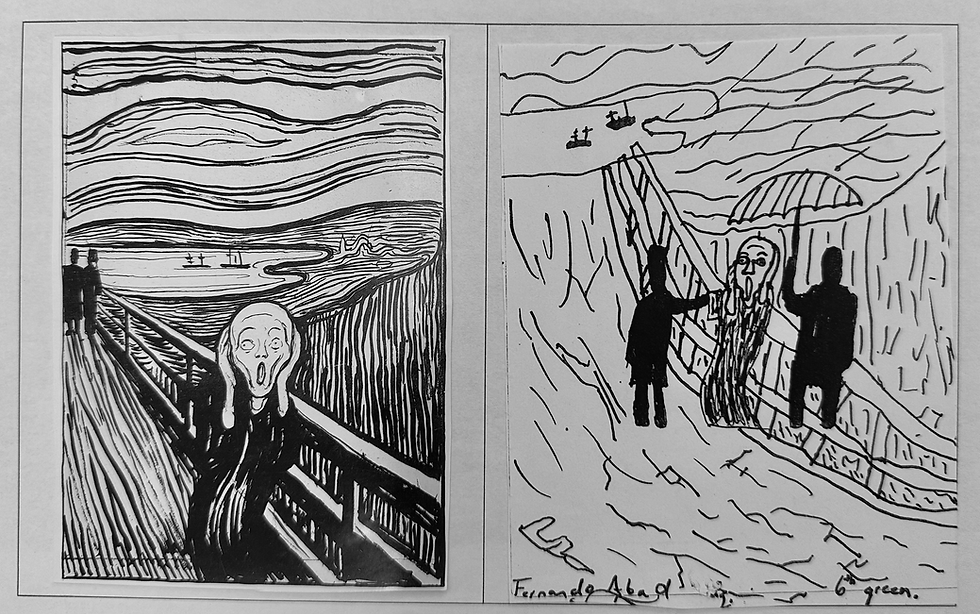
Fernanda, grade 6, imagined and then drew the two figures in the background helping the uncertain figure in the foreground. In her illustration it is now raining and the two figures approach the screaming figure and offer an umbrella and friendship.
Art Supplies
Photocopies of the lithograph, The Cry
pencil
black marker OR black pen
Optional: add color with colored pencils, markers, or paint
I created this worksheet for my students. Sometimes I use this project as an extra credit assignment. Sometimes it's an art journal assignment for my older students that are required to keep art journals. This project would also make a great sub lesson plan! Depending on time this art assignment could be given on larger paper. Some of the student examples are on 9"x12" paper and others are on the PDF worksheet (above)
The Cry...What Happens Next?
Student Gallery
Students, grades 3-8, were asked to treat The Cry as part of the picture story and draw "what happens next." Students took cues from Munch's drawing style. You will notice similar expressive lines in student artwork even though students were NOT told to create in Munch's style. Many students choose to illustrate the feeling of terror in the screaming figure. Within the process of creating students experimented with Munch's style by using similar rhythmic undulating line qualities and also combining their own drawing styles as well.
Alfredo, Grade 6, created a six page graphic novel about what could happen next. In class we spoke about the life of Edvard Munch, the illnesses in his family, his anxieties, how his art style was not at first popular in the time that he lived. In Alfredo's drawings you can see that the screaming figure's life has turned around and has experienced the acceptance stage of grief after all of the loss in his life and starts creating more artwork. On page 7 the new artwork is on display in a gallery and the famous shriek expression is now a large smile.

Maya, Grade 7, Illustrates that it is now raining, the two figures in the background now have umbrellas. The body of the screaming figure is drawn with wavy lines, that look as if the wind from the storm could possibly carry the figure away. A wave of distress is felt in the screaming figure.

Rodrigo, Grade 5 drew the screaming figure lying down. Perhaps anxiety has led to a panic attack which ended with a collapse? The two people in the distance show concern.

Guillermo, Grade 5, drew the screaming figure returning to the studio to create more art and not allowing the feeling of anxiety to take over but rather embracing the anxious energy to create more art.

Alejandro, Grade 4, drew the screaming figure receiving a message of good news which turns the scream into a smile.

Vivi, Grade 3, illustrates an out of body experience.

Maria, Grade 6, Illustrates the figure lying on the ground after jumping into the fjord. Here you can see the spirit leaving the body.

Victor, Grade 4, illustrates the two figures in the background asking, "Why are you yelling?" Now the screaming expression has become a smile perhaps the question creates a diversion from grief?
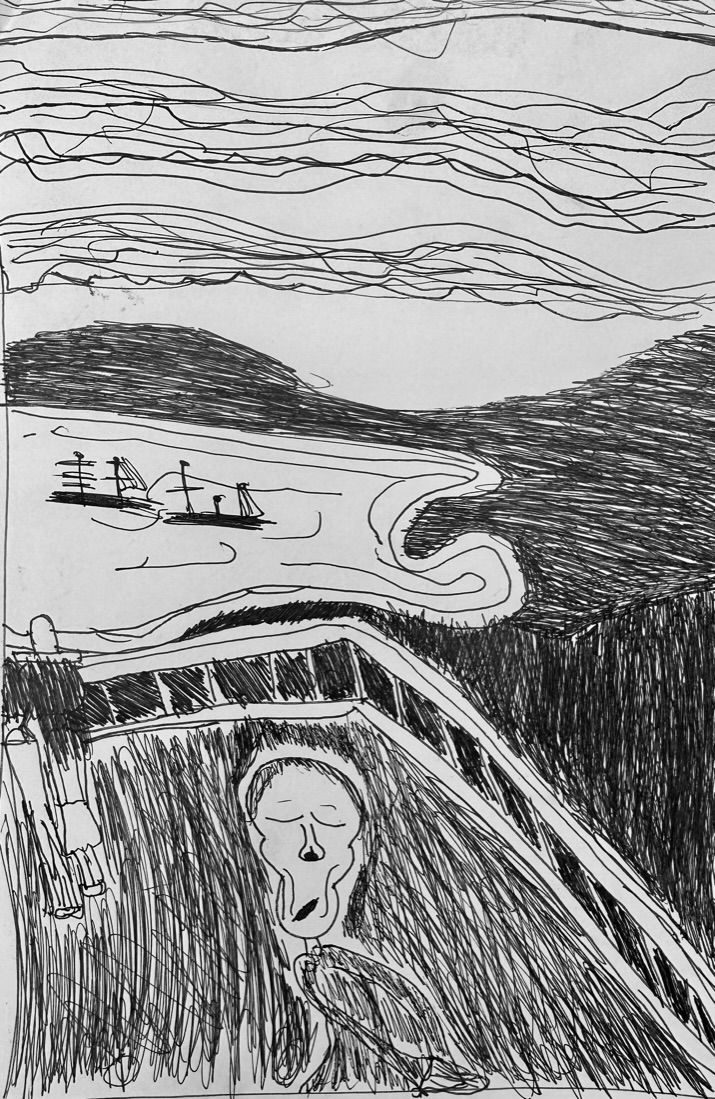
Ariel, Grade 6, illustrates the state of anxiety continuing.

Gerardo, Grade 4, illustrates the body in pieces; a feeling of brokenness.

Maymun, Grade 8, Drew the screaming figure jumping into the fjord using part of the bridge as a diving board and part of the wooden bridge as a boat to float away in. The two figures in the distance watch as the figure floats away.

Fernanda, Grade 6, imagined and then illustrated the two figures in the background helping the uncertain figure in the foreground. In her illustration it is now raining and the two figures approach the screaming figure and offer an umbrella and friendship.
Twittering Machine, Paul Klee

The Twittering Machine,” 1922. This painting is in the collection of The Museum of Modern Art in New York. http://www.moma.org/collection/browse_results.php?object_id=37347
“Reality leaves a lot to the imagination.” ---Paul Klee.
Paul Klee (1879-1940), was born in Switzerland. His mother was a painter and his father was a music teacher. Klee played the violin in a symphony orchestra but he enjoyed art more. In his early years he drew and painted many whimsical pictures from his imagination. He studied the artwork made by children, because he felt that simple shapes and forms best expressed ideas and feelings. Most of Paul Klee's paintings are small and imaginative.
Klee was aware of a group of contemporary artists, called Futurists, who believed that all the newly invented machinery could make a manmade world better than a natural one. Klee did a watercolor and pen-and-ink picture called Twittering Machine, which mocked the Futurist point of view. Klee did not feel machines could make anything as beautiful as nature. In the painting the birds are not realistic and thus suggest that their song would not be natural either.
"Art does not reproduce what we see.
It makes us see." ---Paul Klee.
A Twittering Machine Discussion
Paul Klee, Twittering Machine (Die Zwitscher-Maschine), 1922, 25 1/4 x 19" watercolor, ink, and gouache on paper (MoMA) Speakers: Dr. Juliana Kreinik and Dr. Steven Zucker.Created by Beth Harris and Steven Zucker.

What Might Happen if the handle was turned?
The painting depicts an imaginary machine that looks like it might make music when the handle is turned.
Just for fun...Here is an animated version of Klee's, Twittering Machine and what the Twittering Machine might look like and sound like when the handle is turned....
Just for fun...A sculptural 3D Representation of Twittering Machine homage to Paul Klee
Art Supplies
Photocopies of the Twittering Machine
Paper
Pencils
black pen or ultra fine sharpie
Optional. Add color with Colored Pencils, Markers, and/or crayons.
Kindergarten and Grade 1 students examined, “The Twittering Machine,” 1922. This painting is in the collection of The Museum of Modern Art in New York.
Students were asked…
How do you think this machine might work?
What might happen when the handle is turned?
What kind of sounds do you think the twittering machine makes?
Students were challenged to design their own machines.
Students thought of a name for their machine and explained how it might work and what it does.
Student Gallery
These drawings, by Kindergarten and Grade 1 students accompany artist statements. I asked my students to tell me about their machines and I wrote down everything they said!These are their words...Please read their incredibly imaginative artist statements!

Mimi, Kindergarten

Eitan, Kindergarten

Leon, Kindergarten

Yakova, Kindergarten

Adam, kindergarten

Nati, Grade 1

Moussie, Grade 1

Rivka, Kindergarten
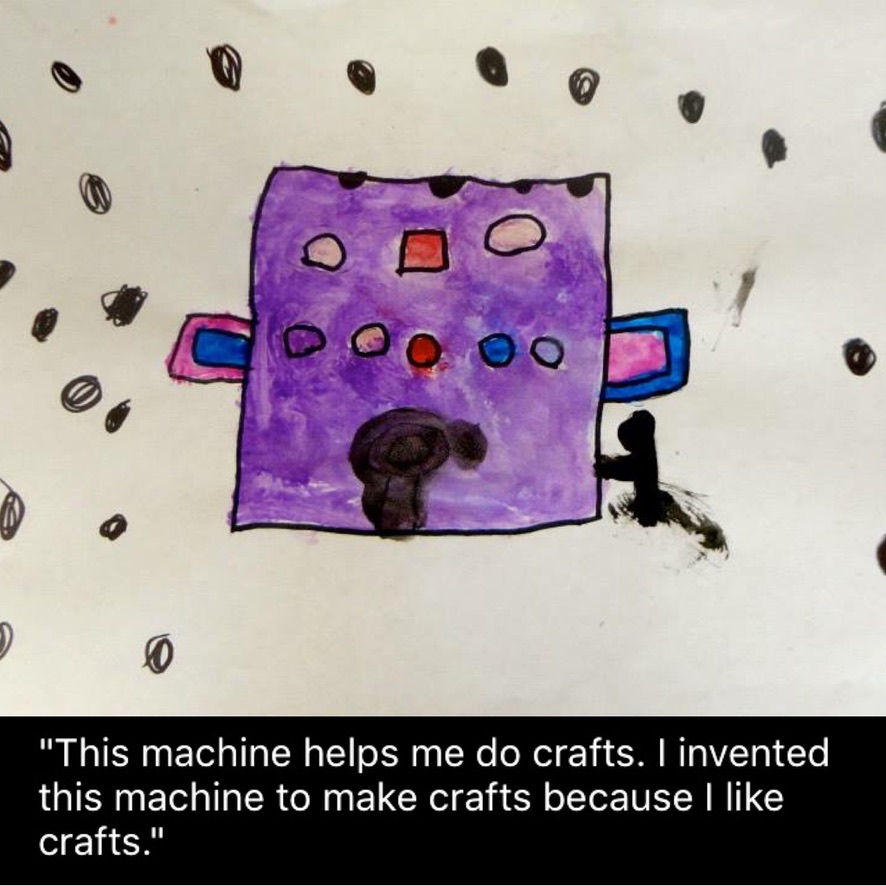
Maya, Kindergarten
A Parade On Another Planet
From Verbal To Visual, making drawings from words.

“Row upon row upon row, as far as the eye can see, marched all the strange creatures of Tamarinanon – the two- headed Pompador with the crickledy necks, and the curious speared and armored Folderol, the great tall one-eyed Cavendish and the three-toed Tootle. Above them Flew the Pom –and Timmins, not quite bird nor insect, with sharp beaks and pointed heads, their gigantic wings flapping in the air - and below them all, creeping along on balloon-like bellies, were the Quangaloons without a nose, this giant long procession of creatures, this never ending parade.”
This art assignment is based on a poem written in the style of Edward Lear.
Verbally inventive descriptions exercise the imagination and lead easily into enjoyable and fun drawing inventive characters. Verbal descriptions were very successful with elementary students and I could see this activity working well with older students as well. Variations on this assignment may involve the setting or context followed by the description of single elements, one at a time until the entire page is filled. One of the most exciting possibilities of creating in this manner is that students, one at a time make up their own verbal descriptions and create drawings from their descriptions.
Students were asked to draw the creatures through verbal descriptions. Students also took turns describing and drawing who was marching behind the next creature.
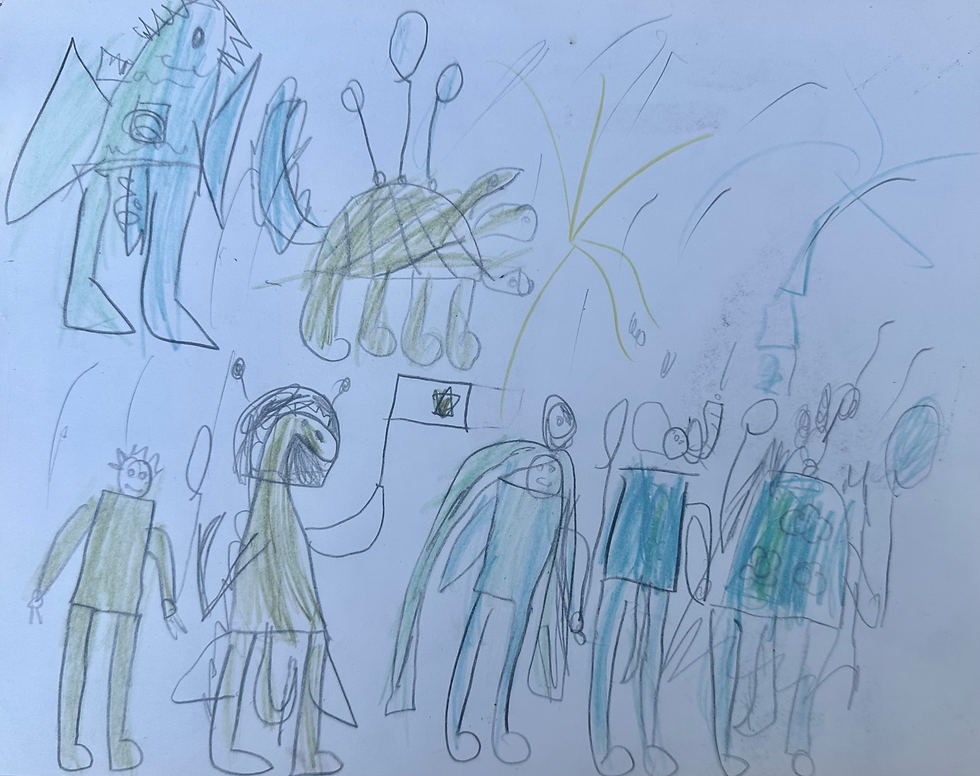
Parade On Another Planet. Gamaliel, Grade 2
This art lesson requires no prep time and works with limited art supplies. If you are looking for a one day art lesson your students will enjoy this one, promise! My students had a lot of fun and it's perfect to sharpen those listening skills!
Art Supplies
Paper
Pencils
black pen or ultra fine sharpie
Optional. Add color with Colored Pencils, Markers, and/or crayons.
This is how I teach this lesson...
I tell students, "Listen carefully to the poem I'm about to read.
The poem is about a -very- BIG Parade on Another Planet!
Listen carefully to the interesting descriptions of the creatures that are in this parade because after I read this poem we are going to draw a parade on another planet!"
After reading the above poem to the class I asked students to imagine being in a parade on another planet....
I say, "Imagine you are on another planet, marching at the head of an enormously long parade. You are leading this parade, YOU are the guest of honor! "
I tell the class, "Today we are going to draw together we will start this drawing by drawing ourselves leading this parade!
Remember this parade is very very long and YOU are at the front of it so that means there needs to be a lot of paper behind you so that we have enough space to draw ALL of the creatures in this parade!"
I draw on the board in front of the class a cartoon version of myself in profile with lots of space behind me.
After students draw themselves in profile on their papers leading the parade we move on..
I describe the creatures one at a time and the class draws from my description.
Descriptions include several details...
I say, "Behind you is a creature with a belly ---out to here---! (use hands to demonstrate how far the belly is extended) ...and FLOWERS growing from the top of his head. That's right, Instead of hair there are flowers growing out of his head!!! "
I draw this creature on the board telling students, "you don't have to draw like me, your creature might look different but don't forget the flowers growing out of it's head, you don't see that everyday! ...Remember we are on another planet so anything might happen!"
we draw together and move onto the next creature. I describe the next creature...
"Okay, behind the man with the belly out to here and the flowers growing out of his head is...
A woman with a beak like a bird and her hair is so very, very, very, very, long!"
We draw the next character together and soon start another one.
By this time the class is excited about the possibilities of what creature might be next in the parade. I wait a few minutes till students catch up and then continue the drawing
"Behind the woman with a beak like a bird and very, very, very, long hair is.....
A Turtle with three heads!"
I remind students that we are on another planet and anything is possible.
I ask students, "What does the turtles shell look like?"
I wait awhile and then the game continues.... I might say,
"A man with the head of an elephant"
"A fish with rocket legs"
I may also add accessories; "You are holding a baton, the man with two heads also has two balloons, the woman with a birds beak and very, very, very, long hair is holding a flag." I might ask, "What's on the flag?"
If there is a lot of space above the parade I might add that not everyone in this parade walks! "Flying above is a bee like creature with a lasso."
To show that we are on another planet I ask students to draw the Planet Earth above the parade and a few other planets. I also suggest adding alien spacecraft and/or rockets above the parade.
Usually I only describe two characters behind the head of the parade and then I randomly select students to tell the class, what's next.
Students descriptions are incredibly detailed and everyone in the class wants to take a turn describing who is next in the parade.
If the class is large I randomly put names into a container and pull out a name.
Students love to share the description of what they are drawing next.
Depending on class dynamics I might not have students take turns describing creatures I may instead have them draw quietly the creatures in the parade and write a list of ideas on the board.
Continue drawing until the paper is filled and the parade looks very long.
If time allows add color.
Ask students to think of a name for their parade?
Ask students to think of names for their creatures?
Ask students what holiday the parade is celebrating?
Ask students why they were chosen to lead this parade on another planet?
If students are old enough to write artist statements. The questions above could be answered in their artist statements.
Parade On Another Planet.
Student Art Gallery
Students were asked to draw the creatures through verbal descriptions. Students also took turns describing and drawing who was marching behind the next creature.

Max, Grade 1

Lilah, Grade 1

Megan, Grade 1

Elyam, Grade 1
If you are looking for art lessons that require little or no prep and can be finished in one or two class periods these art lessons may work for you. They have been student tested and approved fun! Need art sub plans? Consider these. Please tag me on instagram...I can't wait to see what your students create!







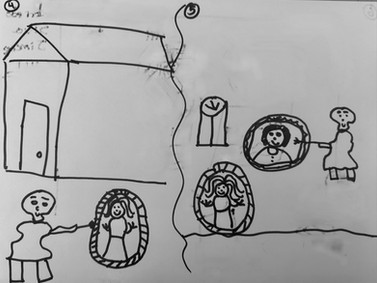





Comments